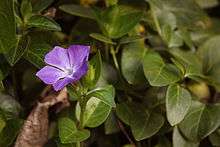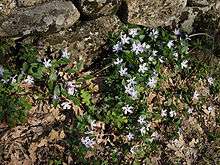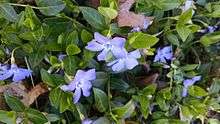Vinca
| Vinca | |
|---|---|
 | |
| Vinca minor | |
| Scientific classification | |
| Kingdom: | Plantae |
| Clade: | Angiosperms |
| Clade: | Eudicots |
| Clade: | Asterids |
| Order: | Gentianales |
| Family: | Apocynaceae |
| Subfamily: | Rauvolfioideae |
| Tribe: | Vinceae |
| Genus: | Vinca L. 1753 |
| Synonyms[1] | |
| |
Vinca (/ˈvɪŋkə/;[2] Latin: vincire "to bind, fetter") is a genus of flowering plants in the family Apocynaceae, native to Europe, northwest Africa and southwest Asia.[3][4][5][6] The English name periwinkle is shared with the related genus Catharanthus (and also with the common seashore mollusc, Littorina littorea).
Description

Vinca plants are subshrubs or herbaceous, and have slender trailing stems 1–2 m (3.3–6.6 ft) long but not growing more than 20–70 cm (8–27.5 in) above ground; the stems frequently take root where they touch the ground, enabling the plant to spread widely. The leaves are opposite, simple broad lanceolate to ovate, 1–9 cm (0.5–3.5 in) long and 0.5–6 cm (0.20–2.36 in) broad; they are evergreen in four species, but deciduous in the herbaceous V. herbacea, which dies back to the root system in winter.[7][8]
The flowers, produced through most of the year, are salverform (like those of Phlox), simple, 2.5–7 cm (0.98–2.76 in) broad, with five usually violet (occasionally white) petals joined together at the base to form a tube. The fruit consists of a pair of divergent follicles; a dry fruit which is dehiscent along one rupture site in order to release seeds.[7][8]
Gardens
Two of the species, Vinca major and Vinca minor, are extensively cultivated as a flowering evergreen ornamental plant. Because the plants are low and spread quickly, they are often used as groundcover in garden landscapes and container gardens. They are also traditionally used in older cemeteries as an evergreen maintenance-free ground cover.[9] Many cultivars are available, with different plant, leaf, and flower - colors, sizes, and habits.
Invasive plant species
Although attractive, both Vinca major and Vinca minor may be invasive in some regions where they are introduced species because of the rapid spreading resulting in choking out native plant species and altering habitats. Areas affected include parts of Australia, New Zealand, Canada, and the United States, especially coastal California.[10][11]

Medicinal use
The vinca alkaloids include at least 86 alkaloids extracted from plants in the genus Vinca.[12][13][14] The chemotherapy agent vincristine is extracted from Vinca rosea (current name Catharanthus roseus),[15][16][17] and is used to treat some leukemias,[18] lymphomas,[19] and childhood cancers,[20] as well as several other types of cancer and some non-cancerous conditions. Vinblastine is a chemical analogue of vincristine[13][16][21] and is also used to treat various forms of cancer.[22] Dimeric alkaloids such as vincristine and vinblastine are produced by the coupling the smaller indole alkaloids vindoline and catharanthine.[13][23] In addition, the nootropic agent vincamine is derived from Vinca minor. Vinorelbine, a newer semi-synthetic chemotherapeutic agent, is used in the treatment of non-small-cell lung cancer[16][24] and is prepared either from vinca natural products leurosine[25][26] or catharanthine and vindoline,[16][27] in both cases by first preparing anhydrovinblastine.[15][16][27]
Species
Accepted species:[1]
- Vinca difformis Pourr. - Azores, W + C Mediterranean
- Vinca erecta Regel & Schmalh. - Afghanistan, Kyrgyzstan, Tajikistan, Uzbekistan
- Vinca herbacea Waldst. & Kit. - C + E + SE Europe, Middle East
- Vinca major L. - S Europe, Turkey, Syria, Caucasus; introduced to & established in New Zealand, California, British Isles, central Europe, Ukraine, North Africa, S China, Canary Islands, Madeira, Mexico, Colombia, Venezuela, Colombia, Costa Rica, Guatemala, S Mexico
- Vinca minor L. - C + SE Europe, Ukraine, Caucasus; introduced to & established in British Isles, Scandinavia, Portugal, Turkey, S China, Virginia, New Zealand
- Vinca soneri Koyuncu - Turkey
References
- 1 2 "World Checklist of Selected Plant Families". Retrieved May 17, 2014.
- ↑ Stearn, W. T. (1983). Botanical Latin ed. 3. David & Charles ISBN 0-7153-8548-8.
- ↑ Flora Europaea: Vinca
- ↑ EuroMed Plantbase Project: Vinca
- ↑ Flora of Pakistan: Vinca
- ↑ Altervista Flora Italiana, genere Vinca included photos plus European distribution maps
- 1 2 Blamey, M., & Grey-Wilson, C. (1989). Flora of Britain and Northern Europe. Hodder & Stoughton.
- 1 2 Huxley, A., ed. (1992). New RHS Dictionary of Gardening 4: 664-665. Macmillan.
- ↑ "Periwinkle". Retrieved 16 November 2012.
- ↑ Global Compendium of Weeds: Vinca major
- ↑ Global Compendium of Weeds: Vinca minor
- ↑ Hesse, Manfred (2002). Alkaloids: Nature's Curse or Blessing?. Wiley-VCH. p. 7. ISBN 978-3-906390-24-6.
- 1 2 3 van Der Heijden, Robert; Jacobs, Denise I.; Snoeijer, Wim; Hallard, Didier; Verpoorte, Robert (2004). "The Catharanthus alkaloids: Pharmacognosy and biotechnology". Current Medicinal Chemistry. 11 (5): 607–628. doi:10.2174/0929867043455846. PMID 15032608.
- ↑ Cooper, Raymond; Deakin, Jeffrey John (2016). "Africa's gift to the world". Botanical Miracles: Chemistry of Plants That Changed the World. CRC Press. pp. 46–51. ISBN 9781498704304.
- 1 2 Gansäuer, Andreas; Justicia, José; Fan, Chun-An; Worgull, Dennis; Piestert, Frederik (2007). "Reductive C—C bond formation after epoxide opening via electron transfer". In Krische, Michael J. Metal Catalyzed Reductive C—C Bond Formation: A Departure from Preformed Organometallic Reagents. Topics in Current Chemistry. 279. Springer Science & Business Media. pp. 25–52. doi:10.1007/128_2007_130. ISBN 9783540728795.
- 1 2 3 4 5 Keglevich, Péter; Hazai, Laszlo; Kalaus, György; Szántay, Csaba (2012). "Modifications on the basic skeletons of vinblastine and vincristine". Molecules. 17: 5893–5914. doi:10.3390/molecules17055893. PMID 22609781.
- ↑ Raviña, Enrique (2011). "Vinca alkaloids". The evolution of drug discovery: From traditional medicines to modern drugs. John Wiley & Sons. pp. 157–159. ISBN 9783527326693.
- ↑ "Chemotherapy for Acute Lymphocytic Leukemia". cancer.org. American Cancer Society. February 18, 2016. Retrieved June 22, 2017.
"Chemotherapy for Chronic Myeloid Leukemia". cancer.org. American Cancer Society. February 22, 2016. Retrieved June 22, 2017.
"Chemotherapy for Childhood Leukemia". cancer.org. American Cancer Society. February 3, 2016. Retrieved June 22, 2017. - ↑ "Chemotherapy for Hodgkin Lymphoma". cancer.org. American Cancer Society. March 29, 2017. Retrieved June 22, 2017.
"Chemotherapy for Non-Hodgkin Lymphoma". cancer.org. American Cancer Society. May 31, 2016. Retrieved June 22, 2017. - ↑ "Chemotherapy for Neuroblastoma". cancer.org. American Cancer Society. January 22, 2016. Retrieved June 22, 2017.
"Chemotherapy for Brain and Spinal Cord Tumors in Children". cancer.org. American Cancer Society. January 21, 2016. Retrieved June 22, 2017. - ↑ Sears, Justin E.; Boger, Dale L. (2015). "Total Synthesis of Vinblastine, Related Natural Products, and Key Analogues and Development of Inspired Methodology Suitable for the Systematic Study of Their Structure-Function Properties". Accounts of Chemical Research. 48 (3): 653–662. doi:10.1021/ar500400w.
- ↑ "Chemotherapy for Non-Small Cell Lung Cancer". cancer.org. American Cancer Society. May 16, 2016. Retrieved June 22, 2017.
"Chemotherapy for Hodgkin Lymphoma". cancer.org. American Cancer Society. March 29, 2017. Retrieved June 22, 2017.
"Chemotherapy for Testicular Cancer". cancer.org. American Cancer Society. February 12, 2016. Retrieved June 22, 2017. - ↑ Hirata, K.; Miyamoto, K.; Miura, Y. (1994). "Catharanthus roseus L. (Periwinkle): Production of Vindoline and Catharanthine in Multiple Shoot Cultures". In Bajaj, Y. P. S. Biotechnology in Agriculture and Forestry 26. Medicinal and Aromatic Plants. VI. Springer-Verlag. pp. 46–55. ISBN 9783540563914.
- ↑ Faller, Bryan A.; Pandi, Trailokya N. (2011). "Safety and efficacy of vinorelbine in the treatment of non-small cell lung cancer". Clinical Medicine Insights: Oncology. 5: 131–144. doi:10.4137/CMO.S5074. PMC 3117629. PMID 21695100.
- ↑ Morcillo, Sara P.; Miguel, Delia; Campaña, Araceli G.; Cienfuegos, Luis Álvarez de; Justicia, José; Cuerva, Juan M. (2014). "Recent applications of Cp2TiCl in natural product synthesis". Organic Chemistry Frontiers. 1 (1): 15–33. doi:10.1039/c3qo00024a.
- ↑ Hardouin, Christophe; Doris, Eric; Rousseau, Bernard; Mioskowski, Charles (2002). "Concise synthesis of anhydrovinblastine from leurosine". Organic Letters. 4 (7): 1151–1153. doi:10.1021/ol025560c.
- 1 2 Ngo, Quoc Anh; Roussi, Fanny; Cormier, Anthony; Thoret, Sylviane; Knossow, Marcel; Guénard, Daniel; Guéritte, Françoise (2009). "Synthesis and biological evaluation of Vinca alkaloids and phomopsin hybrids". Journal of Medicinal Chemistry. 52 (1): 134–142. doi:10.1021/jm801064y. PMID 19072542.
External links
